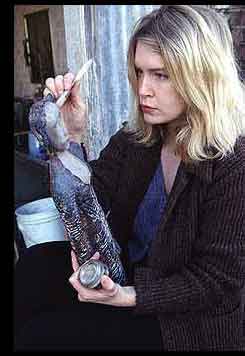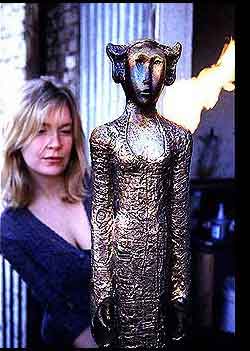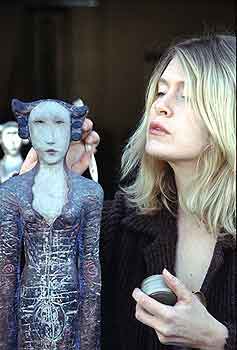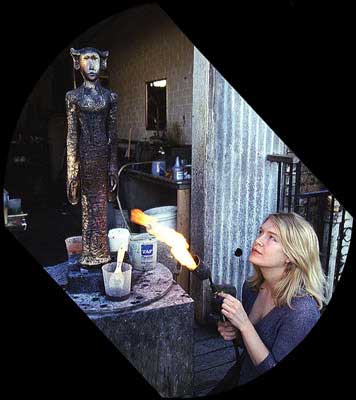A Conversation with Manuel
Neri
MN: Before we talk specifically about what makes
your sculpture so interesting and in some ways unique, could you explain why have you have
chosen clay?
 CV: Clay is really not
my primary material. I use whatever surrounds me, materials that are close to me both
literally and figuratively. I have hundreds of drawings. I draw more than I do any other
art form. Once I begin, it's nearly impossible to stop. Painting and sculpture I can more
easily disengage from, for, let's say a green tea break. The drawings are intricate,
maze-like stream of consciousness black and white ink drawings. I stay up all night
without feeling time pass, but then the rising sun gives away the time. I lose a lot of
sleep this way, I do not set out to translate an idea into an image. I start drawing and
keep going until the page is full. In the end, I am surprised by the myriad of forms,
shapes and characters (human and beast-like) that have appeared. I have also worked with
animal bone to make sculpture and sometimes I just sing - whatever comes to me in a
moment. A melody introduces itself, then words. On "song days" I might not
sculpt or draw, at all. As for ceramics, I can say only that my father works with clay and
it was around in abundance, Also, it is the earth's elastic, the mother's helper. It's
fertile… it feels good in my hands.
CV: Clay is really not
my primary material. I use whatever surrounds me, materials that are close to me both
literally and figuratively. I have hundreds of drawings. I draw more than I do any other
art form. Once I begin, it's nearly impossible to stop. Painting and sculpture I can more
easily disengage from, for, let's say a green tea break. The drawings are intricate,
maze-like stream of consciousness black and white ink drawings. I stay up all night
without feeling time pass, but then the rising sun gives away the time. I lose a lot of
sleep this way, I do not set out to translate an idea into an image. I start drawing and
keep going until the page is full. In the end, I am surprised by the myriad of forms,
shapes and characters (human and beast-like) that have appeared. I have also worked with
animal bone to make sculpture and sometimes I just sing - whatever comes to me in a
moment. A melody introduces itself, then words. On "song days" I might not
sculpt or draw, at all. As for ceramics, I can say only that my father works with clay and
it was around in abundance, Also, it is the earth's elastic, the mother's helper. It's
fertile… it feels good in my hands.
MN: Your - surface treatments
intrigue me. They are rich and layered. They have a child-like appeal and a weathered
quality that connotes both innocence and age. And the engravings seem to contain a secret
code, A personal message. I like that. They seem impossible to decipher, but I keep trying
regardless. That's what holds my interest.
CV: Recently, my mother handed me a
bag full of my babyhood drawings that she had kept, and guess what I discovered... I have
been scribbling the same images since I was a tiny baby. Well, actually, I was a fairly
large baby.
MN: (Laughs) What happy surprise that must have
been.
CV: Yes. It makes me feel as if each
artist is assigned to works that already exist... somewhere... and it is his or her simple
duty to bring those works forth into the physical world.. I'm glad I wasn't assigned to
paint photo-realism.
MN: This seems much more fun.
CV: Absolutely.
MN: Your figures are all similar.
Even their faces.
 CV: Yes. As their most
simple selves, they are alike. People together are like the ocean's coral. Each of us is a
single polyp in a unified whole. We are made unique through color, texture, weathering,
form. Our experiences leave an imprint on us, but our response to these experiences and
their resulting decoration also define us. But behind all that, we are basically the same.
The faces don't matter, but gesture is important.
CV: Yes. As their most
simple selves, they are alike. People together are like the ocean's coral. Each of us is a
single polyp in a unified whole. We are made unique through color, texture, weathering,
form. Our experiences leave an imprint on us, but our response to these experiences and
their resulting decoration also define us. But behind all that, we are basically the same.
The faces don't matter, but gesture is important.
MN: Oh, yes, Yet, if people are, as
you say, basically the same beneath the outer imprint of experience, why do you sculpt
primarily women?
CV: The female serves as a blank
canvas for my own expression because I'm female. I can more easily express through
them the imprints that have shaped me.
MN: Why not men?
CV: Men are ugly.
MN: Really? (both laugh).
CV: No. Women are familiar to me.
I'm taking my time. I've made a few men, but I'm holding them hostage in the studio for
now. Well, actually Green is a man, but he's a maquette.
MN: Tell me about this… little green man.
CV: Well, he's holding a tree as if
it were a baby, but he himself is rather like a child; he's dwarfed by the large wooden
bench he's sitting on. It's green in a couple of ways.
MN: What ways?
CV: He's colored green.
MN: Yes, I see that. But what other ways?
CV: (Laughing) Well, he's young and
naive, which is both wonderful in its innocence and troublesome in its recklessness.
MN: Recklessness and innocence.
These things seem to inspire your own art; much of it retains childhood experiences.
CV: Yes, definitely.
MN: Are there other sources of
inspiration for your art?
 CV: The ocean tends to take in garbage and spit it out as impossibly beautiful
art. A piece of styrofoam becomes a tiny replica of our cratered moon, a veritable
universe of simplicity and balance. How does the sea manage this Miracle? I would dry up
without the inspiration that the ocean exhales. It is a gift as vital as breath, as is our
whole Earth. Also, my parents engaged my imagination. My mom was a performer (a
wonderful ballerina) and Peter an artist and teacher. When I was 11, and witnessing a
gnome in the Dutch woods, Peter just stood and stared at her with me. He didn't say
"Camille, that is tree stump," and when I squealed, "look at her
tail!" He didn't say, "that is a protruding branch, and. you my dear, are a
nut."
CV: The ocean tends to take in garbage and spit it out as impossibly beautiful
art. A piece of styrofoam becomes a tiny replica of our cratered moon, a veritable
universe of simplicity and balance. How does the sea manage this Miracle? I would dry up
without the inspiration that the ocean exhales. It is a gift as vital as breath, as is our
whole Earth. Also, my parents engaged my imagination. My mom was a performer (a
wonderful ballerina) and Peter an artist and teacher. When I was 11, and witnessing a
gnome in the Dutch woods, Peter just stood and stared at her with me. He didn't say
"Camille, that is tree stump," and when I squealed, "look at her
tail!" He didn't say, "that is a protruding branch, and. you my dear, are a
nut."
MN: What you say about the sea is
interesting. But what washes up on the shore is just that - forms, colors, textures,
harmonies and resonances. Where do the messages you embed in your pieces fit in?
CV: Some "art" smacks you
across the face with its message. I don't have to intellectualize a piece to receive its
message. Every little treasure on Earth has ceaseless messages wrapped in mystery. When I
first saw a flower in bloom, I didn't say "ah, such openness allows one's essence,
one's particular scent to be taken in. Ah, such openness allows the light in. It's the
only way to grow. This is a tiny cosmos." No, I stood there receiving the flower's
quiet medicine, and that was enough.
MN: When I was recently in Florence,
I saw an ancient Etruscan seated figure of a woman that had little cavities in her body
and things embedded in her. Little secrets, personal treasures. Your work reminds me of
this piece. It's an ancient idea, this notion you're using.
CV: Wow. I didn't know that. -That's
a nice feeling.
MN: One of the things, as I said,
that impresses me about your work is the surface scoring. Have you considered perhaps
pushing that element further Maybe covering large areas of the figure with those drawings
of yours, like patches or tattoos, almost creeping over the figure and overtaking her...
CV: ... starting to cover her face,
enveloping her...
MN: Yes.
CV: Sounds creepy. Well, I actually
did that with GardenHer. I drew large patchy areas or her, using an indelible ink
pen. I ended up washing it off. You can't see it, but it's still there, in the way that
experiences, though invisible on the Surface of a persons skin, are still there.
MN: You've been exploring other
media besides clay. What is the story behind that delightful turkey-bone sculpture you
gave me? By the way, I made a setting for that piece.
 CV:
Then that's our first collaboration! Yes, that turkey-bone sculpture was a first for me. I
hadn't eaten meat for 18 years, but then one night after Thanksgiving dinner at my
family's house, after everyone had gone to sleep, I raided the refrigerator and began to
pick at the leftover turkey. As I did, I began noticing the incredible intricacy of the
bones, and I realized the wholeness of each part... each was its own little sculpture
connecting to form the bird. I spent the entire night digging in the carcass, peeling the
skin from the bones, rooting around in the body. The deeper I dug, the more I felt a union
with this animal, and my revulsion toward the carcass eventually dissolved. The sculpture
I made with those bones is, to me, the same as the ink drawings. Visually they are very
different, but I know the connection. It's hard for me to articulate the similarities, but
know what the two share. It's similar to the clay sculptures that contain a secret - a
lady that's really a tree, or a horse that's full of childhood ashes. There are no overt
similarities, but the connection between them seems obvious. I usually wrap only the basic
form, first removing any detail from its surface. Detail, if any, is added in the end.
Today I cut all the appendages off a giant stuffed toucan… beak, wings, feet, etc...
and covered him with clay. He looks like a prehistoric, yet undiscovered cave-dwelling
sea-beast… or a rabbit, maybe? Hey, maybe I'll hang him from the ceiling with fishing
line, so he flies like a bird. We'll see.
CV:
Then that's our first collaboration! Yes, that turkey-bone sculpture was a first for me. I
hadn't eaten meat for 18 years, but then one night after Thanksgiving dinner at my
family's house, after everyone had gone to sleep, I raided the refrigerator and began to
pick at the leftover turkey. As I did, I began noticing the incredible intricacy of the
bones, and I realized the wholeness of each part... each was its own little sculpture
connecting to form the bird. I spent the entire night digging in the carcass, peeling the
skin from the bones, rooting around in the body. The deeper I dug, the more I felt a union
with this animal, and my revulsion toward the carcass eventually dissolved. The sculpture
I made with those bones is, to me, the same as the ink drawings. Visually they are very
different, but I know the connection. It's hard for me to articulate the similarities, but
know what the two share. It's similar to the clay sculptures that contain a secret - a
lady that's really a tree, or a horse that's full of childhood ashes. There are no overt
similarities, but the connection between them seems obvious. I usually wrap only the basic
form, first removing any detail from its surface. Detail, if any, is added in the end.
Today I cut all the appendages off a giant stuffed toucan… beak, wings, feet, etc...
and covered him with clay. He looks like a prehistoric, yet undiscovered cave-dwelling
sea-beast… or a rabbit, maybe? Hey, maybe I'll hang him from the ceiling with fishing
line, so he flies like a bird. We'll see.
MN: Is the majority of your work
representational?
CV: No, I am most comfortable
working in the abstract, I began ceramics working with a series of unrecognizable forms.
An egg carton wrapped in a slab of clay is abstract yet strangely familiar. I like this
dynamic. These figures are only a portion of what I do, but they are important. I Feel my
direction shifting. New elements are coming into play (even with the "ladies")
like the wool on Ethiop-l-Am's head. I am excited to see what is to
become. Tonight, I feel like wrapping this whole ugly world from end to end with our
beautiful Earth's clay.
MN: That's great. It's personal. I
like the mystery. I like the idea of those secret identities. Can you explain what you
hope to achieve in the process of creating these forms?
CV: While I'm working, my only hope
is that the piece is a reverent exchange for the moment of its conception. A sufficient
"Thank you."
MN: And are they sufficient?
CV: I'm not the one to ask...

